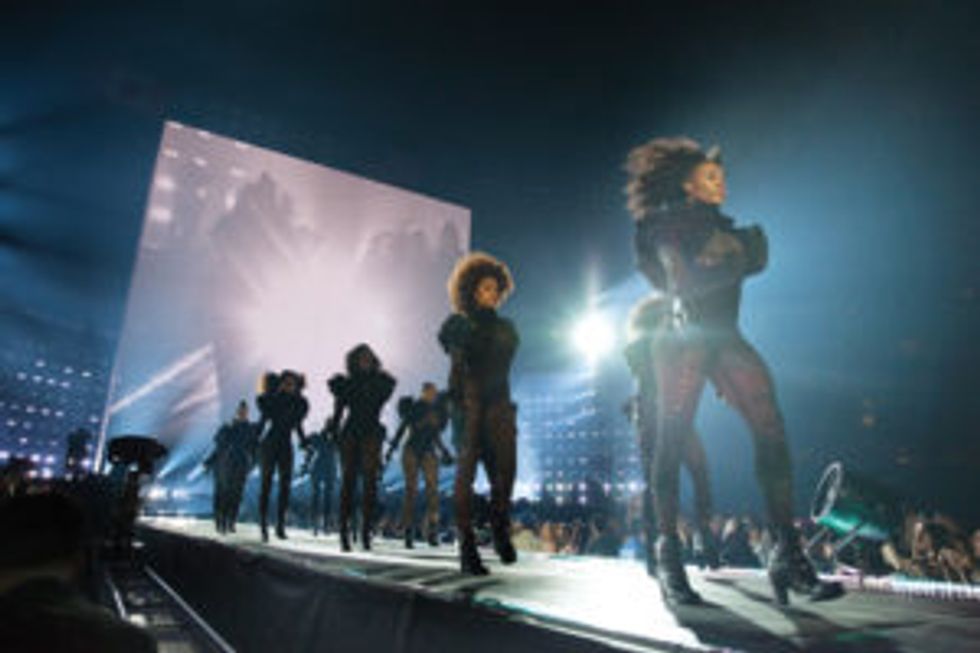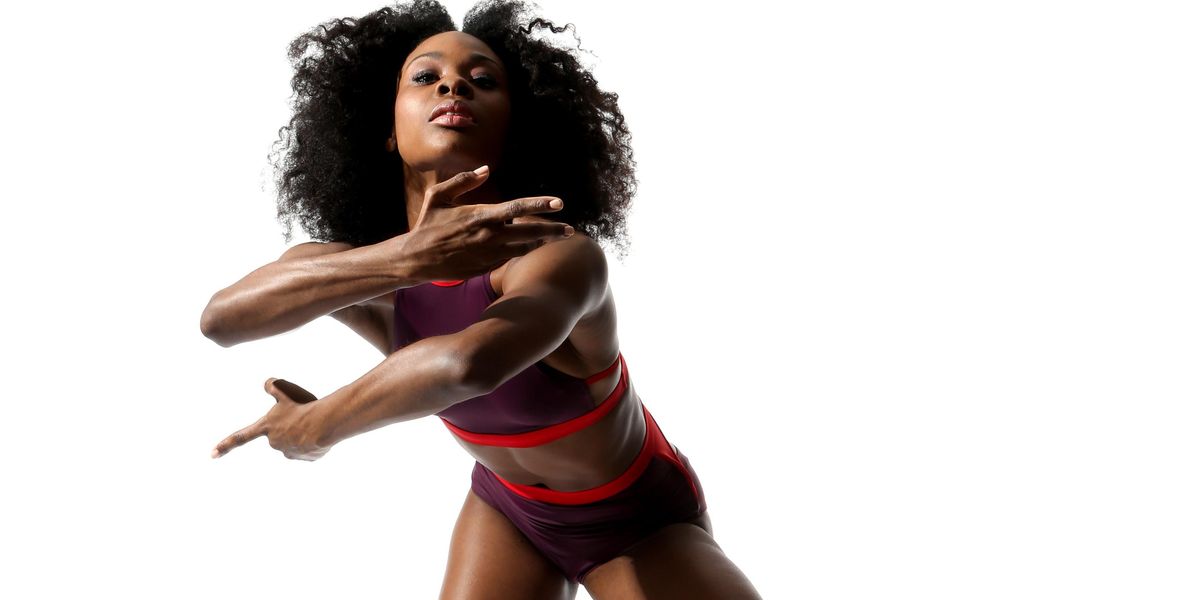Where Her Secret Lies
Ebony Williams stands alone, strong and radiant in a pale leotard, facing a crowd of thousands. It’s the 2015 Made in America Festival in Philadelphia, and the audience of Beyoncé fans is awaiting their queen. Instead of the familiar music, however, poet Maya Angelou’s powerful voice rains down: “Many people wonder where my secret lies…,” and Williams dances. The spectators fall nearly silent—something unheard of at Beyoncé concerts. Angelou describes the “reach of my arms,” “the span of my hips,” “the stride of my step,” and Williams majestically flows between endless extensions and haughty swagger. An immaculate fouetté melts into a sassy stride. A delicate cabriole falls into a luxurious backbend. The solo, choreographed by Williams herself, represents both facets of her eclectic career as a concert dancer who’s conquered the commercial world.
Williams was catapulted into a new chapter of her career last year when, after a decade spent dancing with Cedar Lake Contemporary Ballet, the company unexpectedly shut its doors. Having long used commercial dance as a side gig, she now rocks heels full-time on Beyoncé’s Formation World Tour. But she still carries pointe shoes in her dance bag “just in case.”
Many dancers have a clear-cut path in the dance world. Williams, however, never felt like she quite fit the confines of either the concert or commercial mold. Having mimicked music videos from the time she could walk, she began training in third grade with Boston Ballet’s tuition-free outreach program, Citydance, and started more rigorous classes at Boston Ballet School two years later.
Though her strength made her a standout from a young age, she struggled with being the only black dancer in class and with the cutthroat competition from her peers. She stopped dancing in high school, spending six years away from the studio, but was eventually pulled back. “I always say that dance chose me, because I couldn’t stop missing it,” she says. Acceptance into The Boston Conservatory sealed the deal. While pursuing her BFA, Williams set her heart on joining the newly founded Cedar Lake, which she felt would allow her to incorporate her natural edge. It took less than a year after graduation for that dream to become reality.
She spent 10 years with the company, performing choreography by contemporary masters like Ohad Naharin, Hofesh Shechter and Crystal Pite. “I learned who I was as a dancer and a human,” she says of her time there. “I had the comfort of a company with the freedom to try other things.” During off-time, she danced with artists like Rihanna, Fergie and Ciara, and had a starring role in Beyoncé’s iconic “Single Ladies” music video in 2008. Meanwhile, she savored the intimacy of the concert dance world and the camaraderie of company life at Cedar Lake.
When the company announced its closing in March 2015, Williams felt the hit. The dancers were shocked to hear that Cedar Lake’s founding benefactor had pulled out, and they only had a few months left. “Looking back, I should have seen it coming,” she says. “There was a big shift of energy the last six months to a year. Still, I was shocked and devastated. I pictured myself going to shows as an audience member 15 years from now, watching choreography that was created on me, and seeing how it had evolved. Now that will never happen.”
Instead of panicking, Williams pushed herself in new directions. She took vocal lessons and auditioned for Broadway and film, even making it to a final cut for The Wiz Live! on NBC. She posted her successes and disappointments (complete with comfort food) to a growing social media following. “My goal was to try everything—and to be okay with not being perfect,” she says.

Even on Beyoncé’s Formation World Tour, Williams (far right) practices pointework in her downtime. PC Daniela Vesco, Courtesy Clear Talent Group
It wasn’t long before Beyoncé’s team asked Williams to perform at the 2015 Made in America Festival. She jumped at the chance. “It was a new beginning,” she says. “It was the other half of my dream.”
Since then, Williams has stayed by Beyoncé’s side, marching in formation at the Super Bowl halftime show, breaking the internet with “Lemonade” and, now, on the five-month Formation World Tour. The fast pace of the commercial world initially required some adjustment. “The saying ‘Time is money’ definitely applies,” she says. “The commercial world wants quicker results—from the creation process to learning choreography.” Other big changes include the sheer size of the audiences (many holding up phones or iPads) and the perks: gifts from designers and sponsors.
Williams still embraces her classical roots. Between the 2016 Super Bowl and Formation rehearsals, for example, she traveled to the Netherlands to perform with The Francesca Harper Project at the Holland Dance Festival. She also hopes to find time to work with Richard Siegal on an upcoming project and possibly with Crystal Pite. Despite the absence of regular technique classes, she keeps her body in ballet shape on her own with daily warm-ups and exercises. “I always have pointe shoes with me, and I’ll do relevés while I watch ‘Law & Order’ or HGTV,” she says. “When Francesca Harper asked me to put them on, I had to trust that it was still in my body, like riding a bike.”
Williams also hopes to expand her choreographic and acting skills, and perhaps even spearhead a few projects of her own. In the meantime, she plans to hold the two sides of her dance persona close. “I couldn’t live without either part of my career—the classical or the commercial,” she says. “And I’ll never let either side go, because both are what make me Ebony.”
Preach
Her commercial career has made Ebony Williams more of a nomad, which has given her the chance to focus on another passion: mentorship. She’s hosted workshops across the country, including in her hometown of Boston, and taught at New York City Dance Alliance’s winter intensive. “The young people I teach remind me of myself—sitting there with pen and paper wanting to know it all,” she says.
Her biggest lesson is one she wishes she’d heard at a young age: Be yourself. “In the commercial world, I’m pegged as classical, but in the concert world, I’m considered rebellious and funky,” says Williams. “I’ve felt too skinny in some situations and too big in others. I talk to kids about the fact that I’m still afraid to disappoint. I have to remind myself that I’m here because someone sees the best in me, because I can bring joy to others.” —RZ




